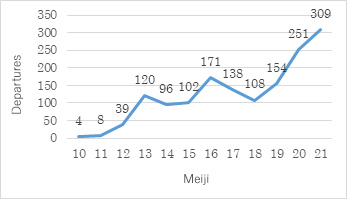4. Rokko Maru: Wooden steamship on the "golden route"
E.H. Hunter founded Osaka Iron Works in 1881, when maritime transport was entering the mainstream of passenger and cargo transport. Timetables in 1884 show that Osaka Shosen Kaisha(OSK Line) operated a primary route from the Port of Osaka via Kobe, Bakan(Shimonoseki), Hakata, and Nagasaki to Hyakkanseki Port(Kumamoto), and a secondary route from Osaka via Hyakkanseki Port to Okawa, along the Chikugogawa River.(1)
The transit time between Osaka and Kumamoto was about 60 hours. Only decades ago, feudal lords were required to travel from up and down Japan to the shogunal capital of Edo(Tokyo) in a practice called sankin kotai. Lord Hosokawa of the Higo(Kumamoto) Domain traveled from Kumamoto by land to Tsurusaki in Oita, by boat to Murotsu Port in Harima Province , and by land to Osaka, and from there proceeded to Edo. The trip took between 33 and 35 days in all, of which 20 days were required to reach Osaka.(2) The sea route reduced travel times between Kansai and Kyushu by a phenomenal degree, though it comes nowhere near today's Shinkansen bullet train, which covers the journey in 3 hours.

This sea route was also a "golden route," with ports of call including commercial centers like Hakata and Nagasaki, and with Kumamoto itself enjoying the coming and going of people and goods, having grown since the Seinan War(aka the Satsuma Rebellion) into an administrative district, military town, and commercial center. The results of a survey by Ichiro Tateyama, presented in the figure to the right, testify to the roaring success of the route: 96 services covered the Port of Osaka–Hyakkanseki Port route in 1881(Meiji 14), and the number increased threefold to 309 services in 1888(Meiji 21).(3)
Hunter was keenly tuned in to the approaching boom in the shipping industry. The Hundred Year History(4) says that in 1880, a year before formally setting up business, he had already completed and delivered the wooden steamship Rokko Maru. It entered service in December that year, covering the route from the Port of Osaka via Kobe, Bakan, Hakata, Nagasaki, and Higo to Kagoshima;(5) and later the secondary route operated by OSK Line.(6) Chinzei Maru, constructed in 1883, went into service and covered the OSK Line primary route the following year. Kumagawa Maru, our first steel ship, also covered the golden route.
Osaka Iron Works rode the wave of the times. It grew into one of the three major shipbuilders of the late Meiji period(1868–1912)—the other two being Mitsubishi and Kawasaki—and enjoyed dramatic development after the First World War. Osaka Iron Works never resorted to support from a powerful zaibatsu conglomerate or financial institution,(7) but instead demonstrated a vigorously "energeric pioneering spirit"(8) in carrying on autonomously, independently, without relying on others. Needless to say, this spirit originates in the Hunter family motto Cursum perficio(Keep the course! Complete the journey!).
Bibliography
- 1立山一郎『明治前期の大阪肥後航路と汽船便』2018年、株式会社日本郵趣出版、33p 掲載の明治17年9月28日付大阪朝日新聞「大阪商船会社社船出港日改正表」
以下本稿で汽船の運航に関することについては本書によらせていただいています。感謝します。 - 2吉丸良治『花畑屋敷四百年と参勤交代』2018年、熊日出版
- 3立山一郎『明治前期の大阪肥後航路と汽船便』2018年、株式会社日本郵趣出版 9p及び130p
「付属資料」本文のグラフ「明治初年における大阪肥後航路の大阪出帆記録数の推移」は「付属資料」から筆者が作成。
(『明治前期の大阪肥後航路と汽船便』立山一郎2018年株式会社日本郵趣出版付属資料から作成/著者が大阪日報などの新聞情報をもとにして作成した資料であり、当時の新聞の事情から欠号も多く全ては網羅できていないと述べられている。) - 4『日立造船百年史』昭和60年、日立造船株式会社、9p
- 5立山一郎『明治前期の大阪肥後航路と汽船便』2018年 134p
- 6立山一郎『明治前期の大阪肥後航路と汽船便』2018年 33p
- 7杉山和雄『造船企業金融史の一考察 –大正前期の大阪鉄工所を中心に–』「金融経済第100号」1966年、株式会社有斐閣、189p
- 8『経営の伝承(創業100周年記念)』昭和60年、日立造船株式会社、2p
Click here for various inquiries
- 1. Maizuru Maru
- 2. Hunter and Aiko
- 3. E.H. Hunter & Co. at Kobe Foreign Settlement No. 29
- 4. Rokko Maru: Wooden steamship on the "golden route"
- 5. E. H. Hunter, a man with Japanese spirit and Western technology (part 1)
- 6. Japanese spirit, Western technology (part 2)
- 7. Bronze statue of E.H. Hunter (part 1)
- 8. Bronze statue of E.H. Hunter (part 2)
- 9. Temple bell tuned to 122 cycles with Shosoin flute